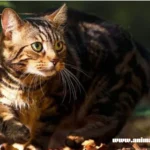Cats are known for his or her agility and beauty, often leaping from one surface to every other with pussycat flair. But if your acrobatic cat hesitates earlier than leaping or hesitates when mountaineering, there is cause for the problem. If you’re wondering why can’t my cat jump all of a sudden, sudden changes in jumping behavior can signal an underlying issue that needs attention. Read more about cat information at Read more about Cat information at animalshub.org.
1. Pain and Discomfort
One of the most common reasons why can’t my cat jump high is pain. Cats are exact at hiding pain, however subtle signs and symptoms may also indicate a situation consisting of osteoarthritis. Osteoarthritis is a degenerative joint disease not unusual in older cats that may cause extreme aches and soreness when jumping. Research suggests that a large percentage of older cats suffer from arthritis, which causes them to become extensively less mobile
2. Mobility Issues
In addition to arthritis, different mobility troubles could affect your cat’s ability to leap. Why can’t my cat jump could be due to medical conditions such as joint dysplasia or old fractures, which can cause restricted movement and pain when jumping. Cats with mobility problems might also avoid stairs or stroll more slowly, indicating an ache or weak point that affects their capacity to jump.
3. Vision Problems
Cat’s imaginative and prescient plays an important role in its playful conduct. Cats rely upon sight to efficaciously judge distance and touchdown. If your cat has imaginative and prescient issues, including blindness or eye disease, he needs to be extra cautious to avoid leaping to keep away from falling. Why can’t my cat use its back legs to jump could be linked to vision problems, such as blindness or eye disease. Cats rely on their sight to accurately judge distance and landing spots. Health situations related to high blood stress also can cause a sudden loss of imagination and anticipation and affect confidence while jumping.
4. Heart Disease
Heart sickness could make a cat weaker and less agile, affecting its overall level of activity. If you’re wondering why can’t my one-year-old cat jump well, it could be related to a heart condition. Cats with heart disorders may also show signs and symptoms of fatigue, shortness of breath, or decreased interest in bodily pastimes. If your cat appears less possibly to leap or interact in regular exercising, it’s crucial to preserve cardiovascular fitness in thoughts as a likely element.
5. Muscle Weakness Due to Kidney Disease
Kidney ailment is another possible cause of reduced jumping capability. If you’re wondering why can’t my cat jump up anymore, kidney disease could be a factor. Cats with kidney disease frequently expand muscle weak spots because of protein loss due to immoderate urination. This weakness could make jumping very difficult and unattractive. In addition, other signs, consisting of prolonged thirst and improved urination, may be associated with kidney disorders.
6. Behavioral Changes
In a few instances, cats virtually learn how to bounce into fantastic territory because of an awful tale or an alternate environment. For example, a cat may also stop jumping on a desk if it pals it with a bad deal, such as loud noises or ugly faces. Behavioral modifications can on occasion explain the discount in missed visits without underlying fitness troubles.
7. Accidental Injuries
Even injuries that are not right away obvious can affect a cat’s potential to jump. Look for signs and symptoms and signs and symptoms of pain on your cat’s feet or limbs, inclusive of broken or sunken nails or incidents that can be inflicting the pain. Leaning or resting on the leg even as climbing or jumping can also imply an injury that calls for veterinary attention.
Conclusion
Determining why can’t my cat jump up requires careful observation and consideration of several factors. From pain and mobility issues to imagination and attention issues to coronary heart disease, there are many possible causes for decreased jumping. If you see an alternative to your cat’s interests or suspect that she is in pain, be sure to consult your veterinarian. Early diagnosis and treatment can help relieve pain and improve your cat’s prime existence so that she can enjoy her fast and playful nature.




